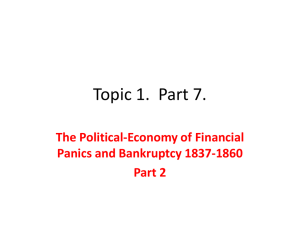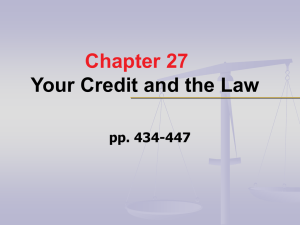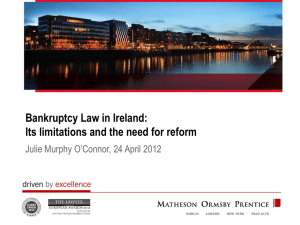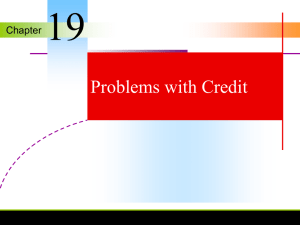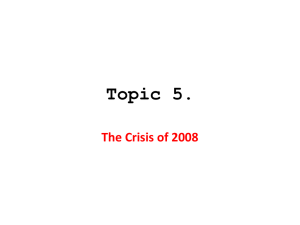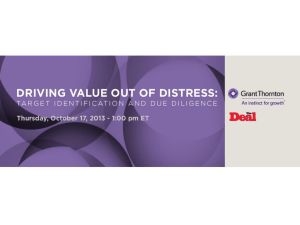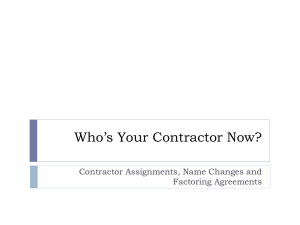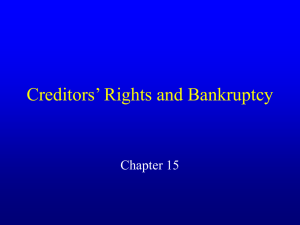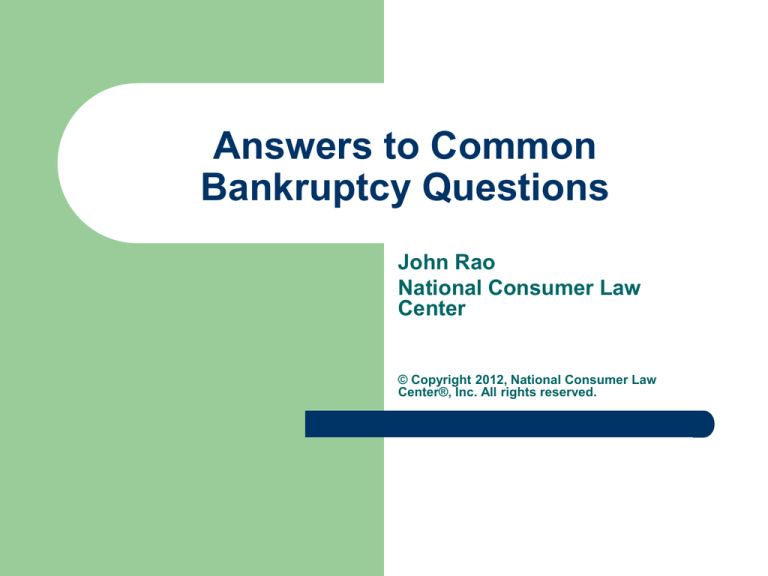
Answers to Common
Bankruptcy Questions
John Rao
National Consumer Law
Center
© Copyright 2012, National Consumer Law
Center®, Inc. All rights reserved.
What is Bankruptcy?
Bankruptcy is a process designed to help
individuals and businesses get protection from
their creditors
Right to file for bankruptcy is provided by
federal law
All bankruptcy cases are handled in federal
bankruptcy court
What Can Bankruptcy Do?
Bankruptcy may make it possible to:
Eliminate legal obligation to pay most or all debts (even
if debt has become a court judgment)
Stop home foreclosure and allow homeowner
opportunity to catch up on missed payments
–
But bankruptcy does not automatically eliminate mortgages
and liens without payment
Prevent repossession of car and other property (and
even force creditor to return repossessed property)
What Can Bankruptcy Do?
Stop wage garnishment, debt collection
harassment, and similar creditor actions to
collect a debt
Restore or prevent termination of utility
service
Lower the monthly payments on some debts
Allow consumer to challenge claims of
creditors who have committed fraud or are
trying to collect more than is really owed
What Bankruptcy Can Not Do?
Bankruptcy does not cure every financial problem
Nor is it right step for every individual in financial
trouble
In bankruptcy, it is usually not possible to:
Eliminate certain rights of “secured” creditors
Discharge some types of debts, such as child
support, most student loans, criminal fines, and
most taxes
Protect cosigners on debts (except in chapter 13)
Discharge debts that arise after bankruptcy is filed
Who Files Bankruptcy?
2012 BankRate survey:
–
–
half of all Americans do not have enough
savings to cover 3 months of normal living
expenses
28% (largest group) have no emergency
savings
2011 study: half of families could not come
up with $2,000 from savings, friends, family
or borrowing to deal with a financial
emergency
Who Files Bankruptcy?
Consumer Bankr. Project, 3 Harv. L. & Pol'y Rev.
87 (2009)
Age of filers went up from 1991 to 2007 - more
financial vulnerability among the aging
Median age of population as whole went from
33.1 to 36.1 from 1991 to 2007; in bankruptcy,
it went from 36.5 to 43
Sharpest increase: 55 and older
Of 2007 bankr. filers, 22% were 55 or older
When Do Consumers File Bankruptcy?
Broke: How Debt Bankrupts the Middle Class
Despite debt problems, most delay filing and suffer
silently
Most unwilling to admit financial failure
Women experience far more stress in prebankruptcy period
But, delay can be appropriate if consumer is
“judgment proof”
What About Alternatives to Bankruptcy?
Credit counseling can help but most often
consumers are too hopelessly in debt by the time
they are considering bankruptcy
Housing counseling should be considered in
foreclosure situation
Consumers should be advised to avoid debt
settlement and debt relief scams
What Are Some Key Bankruptcy
Concepts?
Automatic Stay:
Filing bankruptcy instantly creates an “automatic stay”
Temporarily stops most all creditor actions to collect
debts
However, if consumer had other bankruptcy cases
dismissed within previous year, there may be no
automatic stay or may last only for 30 days
But even then, court can impose or extend the
automatic stay if consumer’s current case has been
filed in good faith
What Are Some Key Bankruptcy
Concepts?
Fresh Start:
Goal of bankruptcy to provide help with existing
debts and give consumer a second chance
financially
Two key elements to bankruptcy fresh start:
Discharge:
Elimination of the legal obligation
to pay a debt
Exemptions: Property which the law allows a
bankruptcy “debtor” to keep
What Are Some Key Bankruptcy
Concepts?
Exemptions:
Bankruptcy estate
Property exempted from the estate
–
–
Two Exemption Schemes
•
Federal
•
State (and federal non-bankruptcy law)
Generally, debtor may choose scheme unless
state has “opted out”
What Are the Different Types
of Bankruptcy Cases?
There are four types of bankruptcy cases individuals can
file:
Chapter 7, known as “straight” bankruptcy or
“liquidation”
Requires individuals to give up property which is not
“exempt”, so property can be sold to pay creditors
But most consumers who file chapter 7 keep all of their
property except:
- property which is very valuable, or
- property subject to a lien which they can not
avoid or afford to pay
What Are the Different Types
of Bankruptcy Cases?
Chapter 13 is a type of “reorganization” used by
individuals
Consumer submits plan to pay all or portion of debts
over a period of years using current income
Homeowner with mortgage default given time to get
caught up, generally over longer period (often up to
3 years) than under workout agreement
Unsecured debts (such as credit cards) may be paid
either in full or a percentage of amount owed, over a
3 to 5 year period
Late charges and interest after chapter 13 filed do
not have to be paid on unsecured debts
What Are the Different Types
of Bankruptcy Cases?
Chapter 11, known as “reorganization,” is used by
businesses and a few individuals whose debts are very
large
Chapter 12 is for family farmers and fishermen
Most
consumers file under either chapter 7 or
chapter 13
Either type of case may be filed individually or by
a married couple filing jointly
What Must Be Done Before Filing
Bankruptcy?
Credit Counseling:
Consumer must receive budget and credit
counseling “briefing” from an approved agency
within 180 days before bankruptcy case is filed
Agencies are approved by the United States Trustee
Program
Briefing may be provided by in-person, telephone or
Internet, and in individual or group session
Consumers should be advised to complete
counseling as soon as they think bankruptcy may be
an option, especially if they may need to stop a
foreclosure sale
Can Credit Counseling Requirement be
Waived?
Counseling may be waived if debtor is:
- disabled,
- incapacitated, or
- on active military duty in combat zone
Counseling may be deferred for 30 days after case
filed if:
- “exigent circumstances” exist, and
- debtor requested counseling from approved
agency, but was unable to obtain services
during five-day period after request made
Can Counseling Fee be Waived?
Most approved agencies charge between $20$50 for the pre-filing counseling
Approved agencies must provide bankruptcy
counseling and necessary certificates without
considering ability to pay
If consumer cannot afford the fee, should ask
agency to provide counseling free of charge or
at a reduced fee
What Does It Cost to File Bankruptcy?
$306 for chapter 7 filing fee; $281 for chapter
13 filing fee
Approx. $20-50 for credit counseling briefing
and $20-50 for education course
Attorney fees have gone up since 2005
Can Bankruptcy Filing Fee be Waived?
Chapter 7 filing fees may be waived
Debtor’s income must be below 150% of
poverty line
(figures for 2012 are $$22,695 for a family of 2
and $34,575 for a family of 4), and
Debtor must be unable to pay filing fee in
installments
Who is Eligible to File Chapter 7?
“Means Test”
Bankruptcy judge can dismiss chapter 7 case if filing is
an abuse of bankruptcy system
“Means test” was added in 2005 to make it more
difficult for wealthy consumers to file a chapter 7
bankruptcy
Most consumers who file bankruptcy are not affected
by this change
Consumers with household income below state
median family income are protected by a “safe
harbor” and not subject to the means test
Who is Eligible to File Chapter 7?
Consumer with income above median must fill out form
that compares monthly income with actual and
assumed expenses in variety of categories
–
national median family income for a family of 4 in 2012 ranged
from a low of under $56,365 in New Mexico to $105,175 in
New Jersey
Some expenses are based on IRS collection guidelines
If form shows that consumer should have certain
amount left over to pay unsecured creditors,
bankruptcy court may decide consumer can not file
chapter 7 case, unless there are “special
circumstances”
What About Homes, Cars and Other
Secured Property?
Bankruptcy usually does not eliminate a
creditor’s lien or security interest on property
Secured creditor may be able to foreclose on a
home or other property, usually after the
bankruptcy case, if consumer does not take
some action
>>>
What About Homes, Cars and Other
Secured Property?
In a chapter 13 case, consumer may be able to
keep secured property by:
Paying the value of the property rather than the full
amount owed on the debt (but usually not on auto
loans taken out within 910 days of the bankruptcy
and home mortgages), often at a lower interest
rate; or
Paying the amount needed to catch up on back
payments and get current on the loan
>>>
What About Homes, Cars and
Other Secured Property?
In a chapter 7 case, a consumer may be able to keep
certain secured property by:
Agreeing to keep making payments on the debt until it
is paid in full (some creditors may request a formal
“reaffirmation” agreement, which must be filed with the
bankruptcy court), or
Paying the creditor the amount that the property is
worth (this is called “redemption” and must be made
with a lump sum payment)
What Must the Consumer Do to
Complete the Case?
After the case is filed, consumer must complete an
approved course in personal finances
Course takes approximately two hours to complete
Course may be taken in-person, by phone or Internet
If fee charged, course must be provided without regard
to ability to pay
Certificate of completion must be filed with bankruptcy
court to get discharge
Does Bankruptcy Affect the
Consumer’s Credit?
Bankruptcy can stay on consumer’s credit
report for ten years, rather than normal seven
years for other credit information
Bankruptcy usually does not make credit
record any worse, if there have already been
numerous reports of defaults
>>>
Does Bankruptcy Affect the
Consumer’s Credit?
Some creditors lend to recent bankruptcy filers
because all or most of consumer’s past debts have
been discharged and consumer cannot get a discharge
in another chapter 7 case for period of 8 years
Bankruptcy may be problem in getting approved for
conventional home mortgage
But most lenders will still provide mortgage if consumer
has reestablished good credit for period of two to four
years after discharge
And should not affect eligibility for reverse mortgage

